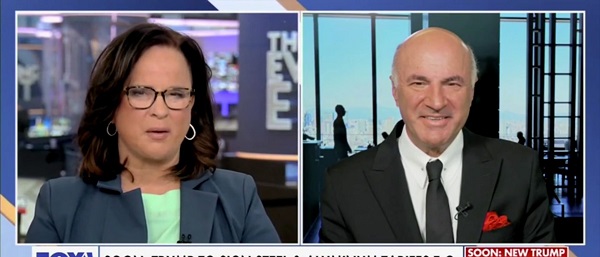Daily Caller
Kevin O’Leary Says Trump’s Tariffs A Gateway To US-Canada Economic Unity


From the Daily Caller News Foundation
By Mariane Angela
‘It’s The Beginning Of A Giant Negotiation’
“Shark Tank” co-star Kevin O’Leary said Monday on Fox Business that President Donald Trump’s looming tariff on steel and aluminum imports have broader implications for US-Canada relations.
During an appearance on “The Evening Edit,” O’Leary discussed the impact of tariffs as the start of significant negotiations. He said there is potential for broader economic integration between the U.S. and Canada. Trump plans to impose tariffs of 25% on imports from Mexico and Canada, along with an additional 10% tariff on Canadian oil, natural gas, and electricity. Despite these significant figures, Trump has imposed only a 10% tariff on oil, the cheapest U.S. imports. O’Leary said this is merely the opening move in what could be a transformative economic negotiation.
“So all of this to me, if you separate the signal from the noise, forget the noise. The signal is, let’s get an economic union together,” O’Leary said. O’Leary said there is a global uproar over the U.S.’s proposed 25% tariffs and the reciprocal tariffs from countries like India, which have set their tariffs on some U.S. products at up to 23%.
“Those are two different baskets. Obviously, the one that people are talking about quite a bit tonight is India. They’ve got certain product services in different sectors, up to 23%. Now we’re going to have reciprocal tariffs in the U.S. against them. [Indian Prime Minister Narendra] Modi will immediately fly to Washington. The negotiations will begin,” O’Leary said.
O’Leary, however, said Canada’s situation differs from others.
“It’s the same everywhere. The Canadian situation is unique. Almost the entire 200 million deficit that the president’s talking about comes from one single source. That’s energy coming out of Irving Refineries on the east coast down to Boston, and all of that oil, 4.3 million barrels a day coming in at Alberta into the west,” O’Leary said. “And so that’s the most inexpensive oil [that] the U.S. imports. That’s why he only put a 10% tariff on it. But it’s the beginning of a giant negotiation. Aluminum, 70% of aluminum comes in the U.S. It’s made in Canada for one singular reason.”
While some skeptics doubt Canada’s willingness to merge economies, a growing number of Canadians, O’Leary said, are open to exploring such a possibility.
“What is on the table that now 43% of Canadians want to explore more of? Forget all these tariffs. Let’s join the two economies, become a behemoth, common currency perhaps, and then take on China,” O’Leary added. “I mean, that’s really what we’re talking about here. We’re talking about the security of the north, not the 49th parallel.”
When asked about what the U.S. could gain from such tariffs beyond economic leverage, O’Leary said it’s about the broader geopolitical benefits:
“Let me assure you that 11 out of 10 Canadians would rather trade their Trudeau pesos for American dollars. They already have American dollar accounts. Trudeau has wiped out 41% of their net worth the last nine years. They want an economic union because it’s good for business. Everybody understands that. The two countries are so intertwined, and they both believe in democracy and free speech and freedom and all the rest,” O’Leary said.
O’Leary was asked what can Trump get for the American consumer and the American voter in return for these tariffs.
“Security on energy,” O’Leary said.
“Alberta has five times more oil and gas than the entire United States. Complete security on uranium, aluminum, all of the incredible resources Canada has with only 41 million people there and access to it in a free flow. No tariffs.”
Trump aggressively employed tariffs to coerce Canada and Mexico into making concessions aimed at resolving the crisis at the southern border. In response, Canada has committed to bolstering security along its northern border, while Mexico has agreed to station 10,000 National Guard troops at the border.
During former President Joe Biden’s tenure, approximately 8.5 million migrants were encountered at the U.S.-Mexico border, and this period also saw an increase in fentanyl seizures, primarily driven by Chinese chemical companies. Meanwhile, even though less frequent, illegal crossings at the northern border also surged during the Biden administration.
Daily Caller
DOJ Releases Dossier Of Deported Maryland Man’s Alleged MS-13 Gang Ties


From the Daily Caller News Foundation
By Katelynn Richardson
The Department of Justice (DOJ) released documents Wednesday demonstrating Kilmar Armando Abrego Garcia’s membership in the MS-13 gang.
Abrego Garcia’s police interview, immigration court rulings and Department of Homeland Security (DHS) deportable/inadmissible alien record highlighting his membership in the gang, which he has disputed in court, are included in the release.
In a December 2019 decision, the Board of Immigration Appeals dismissed Abrego Garcia’s challenge to an immigration judge’s factual finding that he is “a verified member of MS-13.”
The board found the immigration judge “appropriately considered allegations of gang affiliation against the respondent in determining that he has not demonstrated that he is not a danger to property or persons.”
Officers found Abrego Garcia loitering in a Home Depot parking lot on March 28, 2019, wearing “a Chicago Bulls hat and a hoodie with rolls of money covering the eyes, ears and mouth of the presidents on the separate denominations,” the initial Prince George’s County Police Department Gang Field Interview Sheet states.
“Wearing the Chicago Bulls hat represents that they are a member in good standing with the MS-13,” the document states. “Officers contacted a past proven and reliable source of information, who advised Kilmar Armando ABREGO-GARCIA is an active member of MS-13 with the Westerns clique. The confidential source further advised that he is the rank of ‘Chequeo’ with the moniker of ‘Chele.’”
The administration became embroiled in a legal dispute after Abrego Garcia, who entered the country illegally in 2011, was deported in March to El Salvador as a result of an error. In court records, they argued Abrego Garcia could not “relitigate the finding that he is a danger to the community.”
A lower court ordered his return, but the Supreme Court required it to clarify the order and directed the administration to “facilitate” Abrego Garcia’s release.
The Department of Justice (DOJ) indicated Wednesday that it would appeal the amended order Judge Paula Xinis issued which directed the government to “take all available steps to facilitate the return of Abrego Garcia to the United States as soon as possible.”
During a Monday meeting with President Donald Trump, El Salvadoran President Nayib Bukele said he would not “smuggle” a terrorist into the U.S.
The Department of Homeland Security (DHS) also released court filings Wednesday showing Abrego Garcia’s wife requested a domestic violence restraining order against him.
Daily Caller
Trump Executive Orders ensure ‘Beautiful Clean’ Affordable Coal will continue to bolster US energy grid


From the Daily Caller News Foundation
By
President Trump signed several executive orders Tuesday that will allow coal-fired power plants to stay online past planned retirement dates, identify coal resources on federal lands, and bolster the reliability of the electric grid. The orders may help the U.S. face an uncomfortable truth: wind turbines and solar panels can’t cost-effectively meet the U.S.’ growing electricity needs.
Coal provides an important source of the reliable and fuel-secure energy needed to keep the lights on. Our organization’s research shows that it is more affordable than wind and solar, too.
Mr. Trump’s executive orders will allow coal operators the flexibility to delay the premature closures caused in part by President Biden’s policies. A May 2024 rule from the Biden Environmental Protection Agency would have forced coal plants to spend billions on unproven technology to capture 90% of their carbon dioxide emissions. If coal plants failed to comply by 2035, they would be forced to shutter by 2039. The Trump EPA has since announced it will reconsider this rule, but the process could take years.
Coal should be allowed to help keep the lights on, especially because U.S. electricity demand is rising. The North American Electric Reliability Council’s 2024 long-term reliability assessment warns that “resource additions are not keeping up with generator retirements and demand growth” in most regions of the U.S. Coal produced 16% of the U.S.’ electricity in 2023, and coal, natural gas and petroleum together produced 60%. Nuclear comprised another 18%. It is folly to believe that the U.S. can meet its growing power demands while kneecapping a significant source of its baseload power.
Not only is reliable baseload power a must for the grid, but electricity generated by coal is less expensive than intermittent resources like wind and solar. It’s easy to understand why: the cheapest source of electricity is from plants that have already been built. Most of the U.S.’ coal fleet is like houses where the mortgages have been paid off. With no loans or interest left to repay, operating costs for existing coal plants typically consist of property taxes, insurance, labor, maintenance, and fuel.
Our organization models the full costs of building enough wind, solar, and battery storage to replace coal, natural gas, and nuclear plants. Powering a grid on wind, solar, and batteries is more expensive than coal because connecting wind turbines and solar panels to the grid entails system-wide costs like constructing new transmission lines. The intermittency of wind and solar means you need more power plant capacity to generate the same amount of power. More power plant infrastructure means more property taxes. More weather-dependent resources means more costs to managing the grid, like turning off wind turbines and solar panels when they are producing too much electricity for the grid to absorb — or conversely, ramping up natural gas generation on cloudy and still days when wind and solar aren’t producing.
Our research incorporates system-wide costs and shows that a realistic midpoint estimate for wind turbines is $72 per MWh. Electricity from new solar can range between $50 per MWh to $85 per MWh. Data from the Federal Energy Regulatory Commission shows that the average coal plant generated electricity for only $34 per megawatt-hour (MWh) in 2020 (the last year of available data). It could be even less expensive for coal plants to generate electricity if states and utilities allowed coal plants to operate more often. In 2024, the coal fleet generated electricity only about 43% of the time. If that approached 80%, costs could go as low as $29.
Keeping America’s “beautiful, clean coal” plants online is the right thing for the country and it is good news for consumers that the U.S. has recognized the electric grid’s reliability hole and decided to stop digging.
Isaac Orr is vice president of research, and Mitch Rolling is the director of research at Always On Energy Research, a nonprofit energy modeling firm.
-

 2025 Federal Election1 day ago
2025 Federal Election1 day agoRCMP Whistleblowers Accuse Members of Mark Carney’s Inner Circle of Security Breaches and Surveillance
-

 Autism2 days ago
Autism2 days agoAutism Rates Reach Unprecedented Highs: 1 in 12 Boys at Age 4 in California, 1 in 31 Nationally
-

 Health2 days ago
Health2 days agoTrump admin directs NIH to study ‘regret and detransition’ after chemical, surgical gender transitioning
-

 Also Interesting1 day ago
Also Interesting1 day agoBetFury Review: Is It the Best Crypto Casino?
-

 Autism1 day ago
Autism1 day agoRFK Jr. Exposes a Chilling New Autism Reality
-

 COVID-191 day ago
COVID-191 day agoCanadian student denied religious exemption for COVID jab takes tech school to court
-

 2025 Federal Election1 day ago
2025 Federal Election1 day agoBureau Exclusive: Chinese Election Interference Network Tied to Senate Breach Investigation
-

 International1 day ago
International1 day agoUK Supreme Court rules ‘woman’ means biological female






